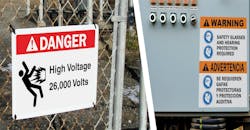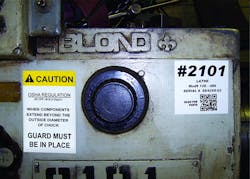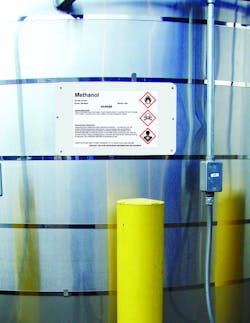The accurate interpretation of safety signs is crucial to prevent injuries and save lives. OSHA has set industry standards that clearly define what a safety sign is, how it should be used, and where it should be placed. However, when it comes to deciding whether to use a sign or a label to convey a message, OSHA leaves that part up to you.
Every facility will have different priorities and constraints when it comes to choosing safety labels and signs. It may often require experimentation with different kinds of materials and designs to determine what is most effective, but these basic definitions apply:
• Safety labels are most commonly made of an adhesive-backed vinyl material to apply directly to a surface.
• Safety signs are constructed from a hard-backed material designed to attach to walls, doors, fencing, and more.
These definitions are not set in stone. To help choose between a safety label or safety sign, let’s go through a breakdown of the most important factors to consider.
How to choose between a label and sign
OSHA does not specify whether a sign or label should be used to communicate vital safety information — as long as the message is communicated in an obvious, long-lasting, and legible way (1910.145).
Labels are most commonly made to convey identification or instruction. They are typically made of an adhesive vinyl material to instantly peel and apply directly to a surface. This makes labels convenient to apply to a variety of items and areas for inventory labeling, product packaging, identifying tools and materials in a warehouse or office, and equipment instructions/warnings for machine guarding, lockout/tagout (LO/TO), and much more.
The main drawback of generic labels is that they are temporary and need to be replaced often. The adhesive will likely corrode, and text will fade when exposed to light and moisture, which makes them ideal for work environments that have little to no exposure to harsh elements.
Labels should provide lasting durability in a variety of environments without fading or peeling away from UV light, moisture, or chemicals. Labels can also be applied to difficult areas like piping systems and valves using tag stock that provides a rigid backing.
Signs consist of a hard-backed material for durable, long-lasting messages that can be hung or mounted on many surfaces. They can be used to create large wayfinding messages, safety instructions, and procedural signs for a variety of workspaces, and other general facility signs that need to remain intact in work environments with different degrees of exposures. Signs can be costlier than labels due to their often-bigger size, higher-quality material, and more complex design elements like graphics and specialized text. Consider the following factors when determining whether a sign or label is the best choice for your needs:
• What kind of environment will the message be in? Will there be minimal industrial and environmental exposures, or will the message likely encounter light, moisture, solvents, chemicals, or other materials?
• How durable must your message be?
• Will the message be indoors or outdoors?
• Who needs to see this message? Consider the amount of information you need to convey. It is important to ensure your messages remain clear and legible to viewers always.
Transform labels into durable signs
Sign blanks are an easy way to communicate safety messages in hard-to-label areas and locations that need temporary signage, such as construction sites, warehouses, and retail businesses. The rigid surface ensures your messages remain reliable and long-lasting. You can also apply multiple labels onto sign blanks to create custom signs, such as communicating site-specific personal protective equipment (PPE) requirements and miscellaneous safety procedures.
Sign blanks can also provide visibility from multiple angles. Double-sided blanks allow viewing from two directions. These work well for messaging in hallways and aisles where visibility is limited. A v-shaped blank allows signs to be seen from 180°. This is ideal for critical safety signs that need to be seen from multiple angles, such as emergency exits and wayfinding.
Sign blanks are available in a variety of materials ranging from strong fiberglass, steel, and aluminum to corrugated plastic. Just choose the sign blank size and material that is best for the environment you’re placing it in. Some blanks come with pre-drilled holes to make them easy to hang on walls or mount to a variety of surfaces and building fixtures using cable ties, nails, or screws.
A steel sign blank is typically made of a ferrous metal (iron) material with a solid steel backing. It’s highly resistant to most chemicals, stands strong to impact, and withstands low temperatures. This material is mainly used for interior signage as it will rust easily.
A corrugated plastic sign blank is good for temporary mounting locations. The tough corrugation provides a thick material that is lightweight and retains its flat surface shape, even after being bent. This material is made for mild environments that will come into little or no contact with prolonged UV exposure, low temperatures, and strong solvents.
Aluminum sign blanks are lightweight and reliable in locations that contain harsh environmental exposures, including chemicals, abrasion, moisture, and sunlight. This corrosion-resistant material can withstand low temperatures and it won’t rust, making it highly durable for outdoor applications. A reflective version can instantly add extra visibility to your message. This material is perfect for low-light conditions and for signs that need to be seen from long distances.
Fiberglass sign blanks are extremely durable. They retain their shape and durability in high and low temperatures as well as exposures from various external stresses. However, contact with strong solvents such as acetone, methyl ethyl ketone (MEK), and trans-dichloroethylene will jeopardize this material.
The use of safety labels and signs are a crucial component of your safety program. Prevent OSHA fines for a lack of hazard communication by using these products to properly alert your workers to potential dangers in the work area.
Rzepecki is a writer for Graphic Products, Inc. For more information, visit www.GraphicProducts.com.



